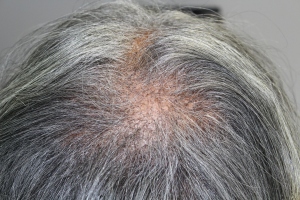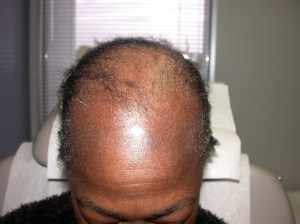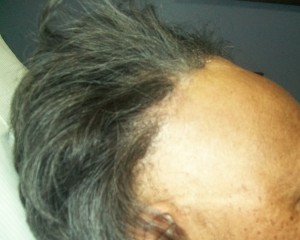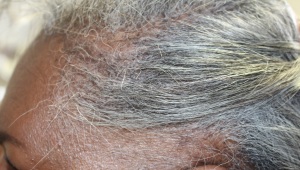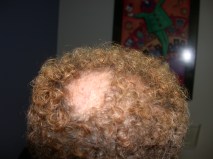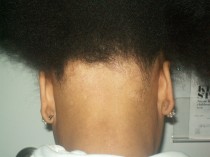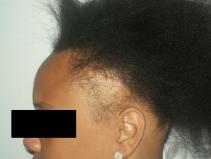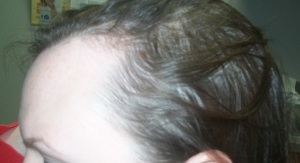Scarring Alopecia
Scarring alopecia is comprised of several different types of hair loss that all lead to permanent loss of the hair follicle.
Central Centrifugal Cicatricial Alopecia (CCCA)
CCCA is a very common form of scarring hair loss caused by traumatic styling. Traumatic styling is considered to be chemical application, heat styling, and pulling hairstyles. Everyone will tolerate these practices at different levels. Some people are very sensitive and have problems right away, and some never experience any difficulty.
Symptoms of early CCCA are loss of individual follicles, intermittent itching, and soreness. Even in the case of eliminating all traumatic styling, some people will continue to have progressive hair loss long term.
Frontal Fibrosing Alopecia
This is a newly emerging form of hair loss that concentrates the loss along the frontal hairline. There may be no discomfort as the frontal hairline slowly moves back. The cause of this is not known, but it requires early treatment as the end result is severe and permanent.
Traction Alopecia
This form of hair loss is from chronic pulling of the hair. It may be caused by hair styles (braids, weaves, ponytails), or aggressive brushing or hair pulling. It usually affects the hairlines, but in the case of ponytails, may affect the top or back of the head. This type of hair loss is initially reversible, but over time, it can result in permanent scarring of the follicle.
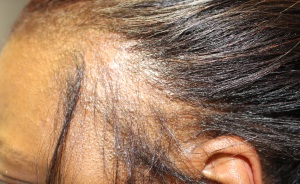 The individual pictured below suffers from a combination of Traction Alopecia + CCCA.
The individual pictured below suffers from a combination of Traction Alopecia + CCCA.
Non-Scarring Alopecia
Non-scarring alopecias are forms of hair loss that do not result in permanent scarring of the hair follicle.
Androgenetic Alopecia (AGA)
AGA is genetically-influenced hair loss that can affect men and women. This is a progressive type of hair loss which requires ongoing treatment to maintain the hair. It is the most common form of hair loss in the world.
Alopecia Areata (AA)
This is an auto-immune form of hair loss in which the body’s immune system attacks its own hair follicles, which it should not do. Affected areas are usually circular, unless they involve a hairline. They can vary in size. They can involve any hairs on the body – scalp, eyebrows, lashes, and even body hair. This form of hair loss may improve spontaneously, but because we have no idea of when this may occur (weeks to years), we provide treatment.
Telogen Effluvium (TE)
TE is hair loss seen after severe physical or emotional stress, especially childbirth and surgery. A large number of hairs is pushed into a shedding phase where too much falls out at once. We are always losing some hairs, but generally <15% are falling out at any one time. In TE, the hairs fall out at a greater rate and can make the affected areas look mildly to severely thin. This form of hair loss usually recovers spontaneously in 1 year or less, but rarely can become long-lasting.
Call Michigan S.K.I.N. Associates to schedule your hair loss consultation – (248) 483-8488!
